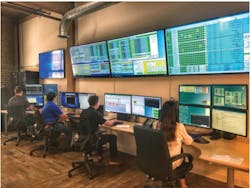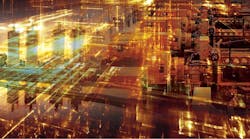Microgrids Can Boost Power Options, Resiliency for Data Centers
Today our topic in the DCF Executive Roundtable is microgrids, which provide access to multiple energy sources. Our discussion took place before this week’s news that Microsoft will integrate a microgrid in one of its new data centers, but that news aligns with our panel’s perspective on the technology’s potential role in the future of the data center industry
Our panelists include Phillip Marangella of EdgeConneX, Shannon Hulbert from Opus Interactive, Schneider Electric’s Steven Carlini, Nancy Novak of Compass Datacenters and Infrastructure Masons, Rob Rockwood from Sabey Data Centers and Brad Furnish of TMGCore. The conversation is moderated by Rich Miller, the founder and editor of Data Center Frontier. Here’s today’s discussion:
Data Center Frontier: Will microgrids play a larger role as the data center industry addresses power constraints in some key markets? What problems could they address?
NANCY NOVAK, Compass Datacenters and iMasons
Nancy Novak, Infrastructure Masons: We certainly think microgrids will increase in importance in the next few years. We’ve even begun to build substations on some of our campuses to reduce power costs and increase reliability.
The grid instabilities over the past few years have provided a wake-up call to the industry that providers are going to have to be more actively involved to ensure power availability to their campuses. I wouldn’t be surprised to see microgrids become de facto requirements on larger projects over the next five years as we continue to deliver more internet-delivered capability.
Now this is probably a distant prediction, but I wouldn’t be surprised if we see some of the businesses larger players begin to act as “quasi-utilities” by generating their own campus power and selling the excess to surrounding communities.
“I wouldn’t be surprised to see microgrids become de facto requirements on larger projects over the next 5 years.”
Nancy Novak, Infrasructure Masons and Compass Datacenters
SHANNON HULBERT, Opus Interactive.
Shannon Hulbert, Opus Interactive: Similar to how demand for liquid cooling for certain areas and use cases are growing, the demand for microgrids also has its place in the connectivity landscape. Whether it’s a region that experiences harsh or unpredictable weather, or fluctuating energy costs, or wild land fires – there is a growing need to have the ability to generate efficient power onsite as needed.
In the interim, there will likely be transitory solutions that help to address power constraints – whether that’s continuing with generators or exploration of nuclear power. Long term, the mix for power could include microgrids with renewables, energy storage, and building as a system monitoring and management that utilizes ML for predictive analytics. The region and use case will likely play a role in where and how these technologies are adopted. Areas with high energy costs and high renewable potential could be early adopters. Rural areas where power access is limited could see microgrids paired with satellite connectivity and drone delivery and surveillance. As the edge gains adoption, demand for micro grids that ensure redundant power for onsite edge deployments will likely also see an uptick.
As a former energy professional, I can now say…and this is what it’s like when worlds collide. Go planet!
PHILLIP MARANGELLA, EdgeConneX
Phillip Marangella: Absolutely. But it may help to view microgrids more as instances of Power Management Software that treats various sources (generators, UPS, BESS, etc.) and sinks (IT load, cooling plants, BESS, etc.) as inherently dispatchable. This software may have multiple objectives, from maximizing the use of renewable power to optimizing for power costs or maximizing deployable IT capacity. But ultimately the objective is to gain greater control over the utilization, cost, and focus of power throughout a data center or campus.
Use cases can be seen today, whether in cloud providers developing time-shifting compute workloads to optimize for carbon emissions, or in batteries being deployed to manage demand changes. In some cases, local power constraints may be behind investment and innovation in this area. But in other cases it is the commitment to more efficient data center operations and an industry prioritizing 24×7 carbon-free energy while aggressively meeting availability and cost goals that is driving interest in the benefits of effective power management.
We believe we’ll see continued investment and innovation from both the hyperscalers and from startup communities looking at building solutions for new use cases like EV charging stations and power delivery to high-density housing.
BRAD FURNISH, TMGCore
Brad Furnish, TMGCore: Yes, Microgrids will play a larger role as we continue to move forward. Obviously, there are some key markets where access to power is becoming more limited, the cost of power is rising, and power delivery is challenging. Several end-users in key markets are now having to plan for the fact that the power they have available today will be the power that they will have for the predictable future, and therefore have to find ways to be more efficient with power utilization. Microgrids provide the ability to reduce those constraints and provide a more harmonious existence between data center infrastructure needs and consumer needs.
The ice storm in Texas highlighted lots of areas for improvement where microgrids can help. Everyone needs critical data center infrastructure to be operational 100% of the time, we also need consumers to have availability to electricity to meet basic needs in harsh conditions. If data center infrastructure has the ability to operate autonomously and in a stand alone fashion, it provides a positive solution for everyone involved.
“The ice storm in Texas highlighted lots of areas for improvement where microgrids can help.”
Brad Furnish, TMGCore
Additionally, there are opportunities to explore sustainable and renewable energy sources that help alleviate constraints. Edge computing, Smart City, and several other strategies/deployments can take advantage of microgrids to get compute exactly where it needs to go without requiring potentially long lead times, build-out schedules or adding to current power constraints, while providing more consistent power availability. Microgrids will play a larger role in the data center industry in very specific use cases in the near term and will continue to evolve.
STEVEN CARLINI, Schneider Electric
Steven Carlini, Schneider Electric: Microgrids offer resilient and sustainable power for data centers to operate independently of the grid during outages and times of crisis. Microgrids help data centers navigate heightened demand and aging infrastructure to ensure mission critical operations stay consistent despite grid uncertainty. Not only do they offer renewable energy sources, but also enable on-site energy for cost savings.
As microgrids proliferate, data center operators will be able to leverage software to automate the selection of power sources based on their desired criteria, including resiliency, redundancy, energy cost, and even sustainability.
ROB ROCKWOOD, Sabey Data Centers
Rob Rockwood: Utility-generated power is overtaxed in certain markets, and microgrids can serve to augment these sources on a semi-temporary basis. Further, renewable microgrids will play a significant role as providers seek to deliver sustainable power “behind the meter.”
NEXT: Are the data center and cloud industries making progress on diversity and inclusion?
Keep pace with the fact-moving world of data centers and cloud computing by following us on Twitter and Facebook, connecting with DCF on LinkedIn, and signing up for our weekly newspaper using the form below:
About the Author









